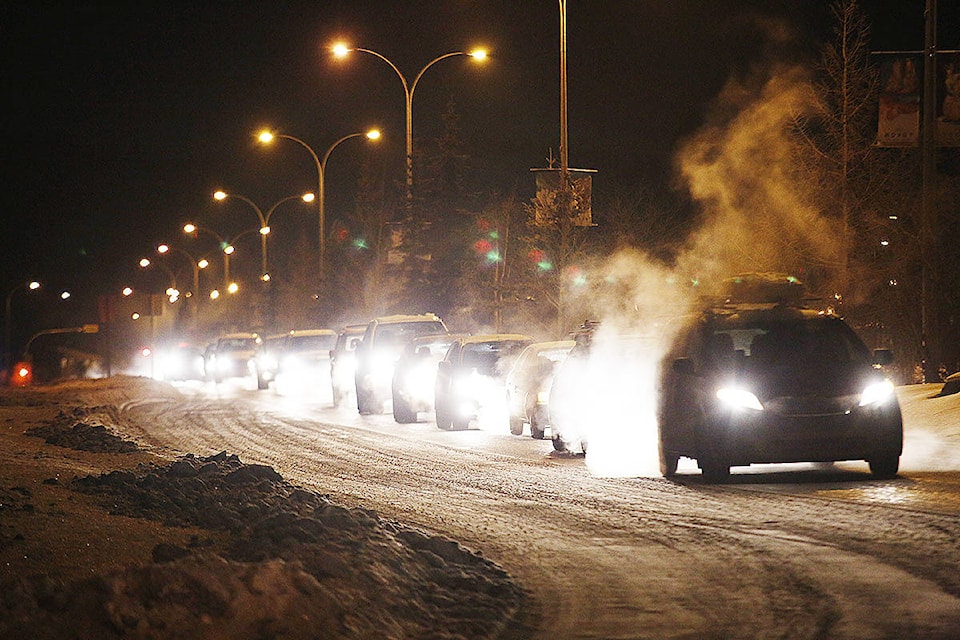Every weekday, for a brief time during the morning and evening rush hours, traffic on Lewes Boulevard in Riverdale grinds to a crawl, if not an outright halt.
For the cars and trucks that are the cause of that fleeting traffic jam as they funnel onto the Robert Campbell Bridge, it’s an annoyance, sure, but one of their own making. Why should transit riders pay the price?
According to city transit officials, the traffic snarls, compounded by all the vehicles dropping kids off at school, can result in buses being up to 17 minutes late. With bus routes as long as Whitehorse’s, that makes it almost impossible for drivers to get back on schedule.
One of the biggest knocks against the city’s bus system is the perceived lack of reliability, which makes it hard to attract and retain passengers. Who wants to wait an extra 17 minutes when it’s -30 C out?
That’s why the city’s weeklong transit lane experiment was so welcome. It proceeded from a simple question — can we speed things up for Riverdale buses? — to a simple idea for a solution: let’s put down some pylons and see what happens when buses don’t have to compete with cars.
The very nature of public government makes it averse to risk. Failed experiments cost money and that makes taxpayers mad. Angry residents call up their city councillor and yell at them. Councillors rake city staff over the coals. Nobody wants to take any chances.
Sometimes, that’s for the best. Witness the Yukon government’s failed attempt to bridge the Yukon River with ice up in Dawson. That experiment fell apart because — who could have foreseen it! — ice forms more slowly when it’s warmer than usual.
It’s not like there weren’t concerns about the bus lane. Lewes Boulevard is wide enough for one lane of traffic and plenty of room for bikes. Some cyclists were understandably concerned about potential conflicts with buses. But Riverdale resident Anthony DeLorenzo said it wasn’t a problem.
“It was a pleasure not having to worry about cars and/or riding in piles of snow,” he told me in a Facebook message. “I was a bit concerned about sharing a narrow lane with a wide bus. In the end I only had to pass a bus once and was able to stay clear of it after I passed.”
Transit and planning experts have generally come to regard the 20th-century bias in favour of roads designed for no other purpose but to move as many cars as fast as possible as a serious mistake.
Cities are starting to repurpose their streets for other users, restoring the balance that historically existed when streets were rights of way for everyone, not just cars. This is not a process that will happen overnight, especially here.
That’s partly for practical reasons — trades workers, for example, often have to haul gear to far-flung work sites. Nobody expects them to lug their gear on the bus.
It’s also because many drivers seem to regard the changes that balance road use as existential threats to their way of life. Ford Nation’s baloney “war on cars” rhetoric is an example of this. But reducing private vehicle traffic by providing alternatives is good for those who must — key word: must — drive.
Enticing people to use public transportation will always be a challenge in Whitehorse. We have a small population that is spread out over a wide area. We won’t be seeing any subways or streetcars here any time soon.
And that’s fine. We don’t need expensive home-run transit improvements. We need smart, modest improvements: more and better bus shelters, better signage, and improvements like bus-only lanes and transit priority signals at intersections.
We also need more ambitious improvements. As members of the Yukon Anti-Poverty Coalition said at a recent city council meeting, one of those is Sunday bus service. It’s not 1957. Most stores are open and people need to get to work.
If you work on Sunday, you basically have to own a car if you can’t walk to your job. And if you own a car, you might as well drive it every day. This is a major hole in the transit system and one the city needs to fix.
The city’s route network also consists of lengthy milk runs that are falling out of fashion with transit planners, who are moving toward shorter, higher-frequency routes with reliable transfer connections.
The city last redesigned the bus network in 2011, and that may be an area transit officials want to revisit, although wholesale route changes are understandably a pain in the neck for riders.
So we await with great interest the city’s transit master plan, scheduled for release in March. And we hope council backs the plan with as many practical transit improvements as the city can afford.
In the meantime, city staff deserve some kudos for trying something that could lead to a relatively simple fix for a major transit headache. Even if it doesn’t, the cost was almost nothing.
Contact Chris Windeyer at editor@yukon-news.com
